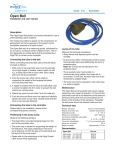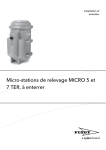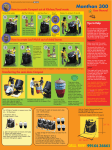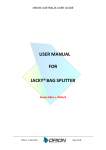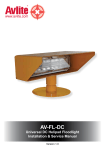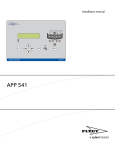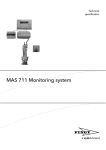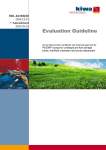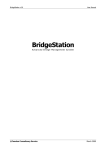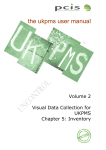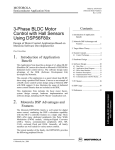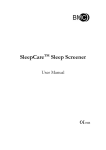Download COMPIT Installation & Maintenance brochure
Transcript
Installation, Operation, and Maintenance Manual COMPIT Ready-to-connect Polyethylene Pump Station for Sewerage Systems Table of Contents Table of Contents Foreword......................................................................................................................................... 2 ........................................................................................................................................................2 Disclaimer...................................................................................................................................... 2 Abbreviations................................................................................................................................. 2 Safety................................................................................................................................................3 ........................................................................................................................................................3 Safety and warning symbols used in the manual..........................................................................3 Requirements to be met by personnel.......................................................................................... 3 Safety regulations for the owner/operator..................................................................................... 3 Modification of the pump station; choice of spare parts supplier..................................................3 Dismantling and assembly.............................................................................................................3 Guarantee........................................................................................................................................5 Xylem undertakes to remedy faults in products sold by Xylem provided.................................... 5 Warranty claims..............................................................................................................................5 Technical description..................................................................................................................... 6 General information........................................................................................................................6 Pump..............................................................................................................................................6 Pump Station................................................................................................................................. 6 Installation........................................................................................................................................8 Safety measures............................................................................................................................ 8 Transport and unloading............................................................................................................... 9 Installation in the ground..............................................................................................................10 Insulation......................................................................................................................................12 Placement of access cover...........................................................................................................13 Installing the extension shaft........................................................................................................14 Installing the pump.......................................................................................................................15 Equipotential bonding...................................................................................................................18 Electrical connections................................................................................................................... 18 ......................................................................................................................................................18 Installing the level regulator..........................................................................................................18 Advice to the Electrician about connecting the Compit...............................................................19 Commissioning............................................................................................................................ 19 Maintenance..................................................................................................................................20 Pump station.................................................................................................................................20 Pump............................................................................................................................................ 20 COMPIT, Ready-to-connect Polyethylene Pump Station for Sewerage Systems Installation Care and Maintenance 1 Foreword Foreword The manual must be supplemented with the regulations set out in legislation to prevent accidents and to protect the environment. The manual must be kept available at the machine/installation. In addition to the instructions in the manual and the national and local regulations for the prevention of accidents, good professional practice must also be observed. Disclaimer Design changes may have been made to technical details, so that the actual product differs from the illustrations and information given here. Copying, transcription, translation or other forms of reproduction are only permitted with the written consent of the manufacturer. This also applies to extracts from the text. Abbreviations Elex-V Ordinance concerning electrical equipment in explosion hazard areas. VDE 0100 Choice and installation of electrical equipment, earthing, protective conductors and equipotential bonding. 2 COMPIT, Ready-to-connect Polyethylene Pump Station for Sewerage Systems Installation Care and Maintenance Safety Safety This manual contains basic information about installation, operation and maintenance. The instructions given should be followed carefully. Installation and maintenance personnel must read the instructions carefully before installing or commissioning the pump station. The operating instructions should always be readily available at the location of the pump station. Safety and warning symbols used in the manual WARNING: General warning: This symbol is used to draw attention to instructions in the manual that are intended to prevent situations that might endanger life. Electrical Hazard: High voltage: This symbol draws attention to situations where a dangerous voltage may occur. NOTICE: WARNING! This symbol is used to draw attention to instructions that must be observed to ensure that no situations arise in which there is a risk of the pump being damaged or failing to run. Requirements to be met by personnel All work must be done by authorised personnel. Safety regulations for the owner/operator All official regulations and local health and safety regulations must be complied with. All electricity-related risks must be avoided (observe the instructions of the electricity supply company). Modification of the pump station; choice of spare parts supplier The pump/installation should not be modified without the agreement of Xylem. Genuine spare parts and accessories approved by the manufacturer are essential for correct operation. The use of other parts may invalidate the warranty. Dismantling and assembly If the pump/mixer has been used to pump hazardous media, care must be taken that, when draining the leakage, personnel and environment are not endangered. All waste and emissions such as used coolant must be appropriately disposed of. Coolant spills must be cleaned up and emissions to the environment must be reported. The pump station must be kept tidy and in good order. All official regulations must be complied with. COMPIT, Ready-to-connect Polyethylene Pump Station for Sewerage Systems Installation Care and Maintenance 3 Safety WARNING: In certain installations and at certain operating points on the performance curve, a noise level of 70 dB or the stated noise level for the pump may be reached. 4 COMPIT, Ready-to-connect Polyethylene Pump Station for Sewerage Systems Installation Care and Maintenance Guarantee Guarantee Xylem undertakes to remedy faults in products sold by Xylem provided • that the fault is due to defects in design materials or workmanship; • that the faults are reported to Xylem or Xylem's representative during the guarantee period; • that the product is used only under condition described in the Installation, Care and Maintenance manual and in applications for which it is intended; • that the monitoring equipment incorporated in the product is correctly connected and in use; • that all service and repair work is done by a work shop authorized by Xylem; • that genuine Flygt parts are used. Hence, the guarantee does not cover faults caused by deficient maintenance, improper installation, incorrectly executed repair work or normal wear and tear. Xylem assumes no liability for either bodily injuries, material damages or economic losses beyond what is stated above. Xylem guarantees that spare parts will be kept for 15 years after that the manufacture of this product has been discontinued. Warranty claims In the unlikely event of having to submit a warranty claim, contact your nearest Xylem representative for information. Please write the serial number below: Serial number: COMPIT, Ready-to-connect Polyethylene Pump Station for Sewerage Systems Installation Care and Maintenance 5 Technical description Technical description General information The Compit pump station is supplied completely assembled and ready to connect. It is intended for use in sewerage applications. Compit can function, for example, as a waste water well for a single house with a connection to natural infiltration, or in branched pressurised sewerage systems. Max load rating for the plastic access cover is 14 lbs/Ft2 but no higher than 265 lbs. The access cover Class A is suitable for any location where it is subjected only to loads from pedestrians or pedal cyclists. The access cover Class B is suitable for footways, pedestrian areas, car parks or car parking decks. The access cover Class D is suitable for carriageways of roads, hard shoulders and parking areas for all types of road vehicles. Because of its design, Compit is safe from being forced up in all normal types of ground. If the instructions are followed, the system will work perfectly. WARNING: The pump station may not be used in any explosive or flammable environment or for pumping flammable liquids. Pump See the installation manual of the pump. Automatic control See the instructions supplied with the automatic control cabinet. Pump Station Technical data The Compit pump station is made in rotomoulded PE (polyethylene). Dimensions 6 See dimensional drawing. (Dimensions in inches.) COMPIT, Ready-to-connect Polyethylene Pump Station for Sewerage Systems Installation Care and Maintenance Technical description Weight (without pump) Single station (pre-assembled), 400 lbs. approx. Extension shaft, 44-88 lbs. depending on length. Maximum allowed pump weight 120 lbs. Delivery content Compit comes ready-assembled. The following items are supplied with the pump station: 1. Well cover. 2. Internal pipes and valves. 3. Operating handle with chain for shut-off valve. Important The pump, discharge kit, control panel and level regulators are delivered separately. COMPIT, Ready-to-connect Polyethylene Pump Station for Sewerage Systems Installation Care and Maintenance 7 Installation Installation Safety measures The following rules must be observed to minimise the risk of accidents during servicing, installation and maintenance: • Make sure that all electrical equipment is insulated from the power supply and cannot be energized. • Never work alone. When working inside the pump station beware of the risk of hazardous gases and always use a lifting harness, safety line and breathing apparatus. Do not underestimate the risk of drowning! • Follow local regulations regarding work in narrow spaces. • Make sure that there are no toxic gases in the work area. • Check the explosion risk before welding or using electric hand tools. • Do not underestimate the health risk. Be meticulous about cleanliness. • Bear in mind the risk of electrical accidents. • Make sure that the lifting gear is in good condition. • Arrange suitable barriers around the work area, eg a safety railing. • Make sure you have a safe exit route! • Use a safety helmet, safety glasses and safety shoes. • All personnel who work on sewage installations must be vaccinated against diseases that may be present there. • A first-aid box must always be easily available. • Note that special rules apply for installation in explosive environments. • Follow local safety regulations. In addition, follow the instructions of The Swedish Work Environment Authority or equivalent body. • Always close and lock the cover before leaving the pump station. General The responsibility for installing the pump station, including the extension shaft, is always borne by the contractor. Gas, dust, vapours, smoke Work that involves welding, gas cutting and grinding may only be done on the machine/installation if special permission has been given. There may be a risk of fire or and/or explosion. WARNING: Before starting welding, gas cutting or grinding, clear all dust and flammable material from the workplace and the area around it. Arrange sufficient ventilation (explosion risk). Transport and unloading Make sure that the tank is not in contact with sharp edges. Protect the tank from severe impacts. Take care during loading and unloading. Before installation in the ground, check that the plastic tank and internal pipework are undamaged. Make sure that the station is unloaded from the truck with a suitable lifting equipment. Always use appropriate ropes. Lift the station to an upright position according to pictures 2a - 2d. 8 COMPIT, Ready-to-connect Polyethylene Pump Station for Sewerage Systems Installation Care and Maintenance Installation WARNING: • Before the transport locking device is removed, a rope must be fastened to Compit according to ill. 2a. • The pump station and pump/s are delivered separately. • Never install the pump/s prior to lifting the pump station. • Make sure that the concrete cover remains on the pallet (2b). • When raising from horizontal to upright position (2c) the pump station will jolt and possibly sway slightly towards the end of the raising position. • Stand at a safe distance until the swaying has stopped. • NB! Use both lifting eyes when lifting the station into the pit (2e). 2a 2b 1 2 1. Rope 2. Transport locking device 2c 2d COMPIT, Ready-to-connect Polyethylene Pump Station for Sewerage Systems Installation Care and Maintenance 9 Installation 2e Installation in the ground The responsibility for installing the pump station, including the extension shaft, is always borne by the contractor. The foundations of the pump station is designed to handle a groundwater table at surface level. Dimensions on the sketch must be regarded as minimum dimensions. The pump station must not be installed in ”dy” or peat. Where the pump station is installed in loose clay or silt, the crushed backfill must be protected from mixing by fibre cloth (A). Excavation must be done to 12 inches below the planned installation level. The shaft must be made at least two metres larger than the tank. A bed of crushed material about 12 inches thick (B), with grain size between 2 and 36 mm must be laid on the bottom of the shaft. The surface is compacted and levelled and the pump station is lowered on to the bed. Backfilling around the tank is done up to at least 28 inches above the bottom of the tank with the same type of crushed material, and compacted with a layer thickness of not more than 5-7/8 inches. The remaining fill (C) must not contain stones larger than 2 inches. This filling must be done before the groundwater surface is allowed to rise above the crushed material. Important Make sure that: • backfilling is properly made around inlet and outlet pipes. • the well is still vertical after backfilling. 10 See Figure 3. COMPIT, Ready-to-connect Polyethylene Pump Station for Sewerage Systems Installation Care and Maintenance Installation Figure 3. 3 ft. 4 in. D 28 in. E C B A 12 in. Insulation The pump station is protected from freezing by horizontal ground insulation, 2-3/4 inches cellular plastic (D), about 12 inches below the surface of the ground. The insulation is extended at least 35-1/2 inches around the pump station in the case of fine-grained soils clay, silt and sand (grain size below 3/4 inch) - and at least 5 ft. 8 inches for coarse-grained soils – gravel and stone (grain size above 3/4 inch). If the pump station is idle in winter – in the case of a summer home or a long absence – the cover and surrounding ground should be insulated. A box insulated with cellular plastic is suggested. Alternatively, supplementary heat from a thermostaticallycontrolled radiator or an immersion heater in the pump sump can be arranged. COMPIT, Ready-to-connect Polyethylene Pump Station for Sewerage Systems Installation Care and Maintenance 11 Installation Placement of access cover Class A and Class B cover Position and fix the cover frame in the center of the station opening. Figure 6. Plastic cover Figure 6.1. Make sure that the two steel brackets are engaged in the PE-cover. 12 COMPIT, Ready-to-connect Polyethylene Pump Station for Sewerage Systems Installation Care and Maintenance Installation Installation Figure 7. Lock the pump station using a padlock Class D cover The design of the concrete slab (fig. 8) is the responsibility of the local consultant or contractor. Figure 8 1 2 1. Concrete slab 2. O-ring 82 92 56 Installing the extension shaft If an extension shaft is used it should be positioned according to figures 9 and 10. Figure 9. Axial position of extension shaft. B D D C A A A Cut in an O-ring slot when adjusting the length of the extension shaft. B Place the O-ring in the second O-ring slot. Put soap water or grease on the O-ring before the extension is assembled. COMPIT, Ready-to-connect Pump Station forPump Sewerage Installation Care and Care and 14 COMPIT,Polyethylene Ready-to-connect Polyethylene Station Systems for Sewerage Systems Installation Maintenance Maintenance 13 Installation C Min 7-7/8 inches, Max 9-7/8 inches D To prevent the extension shaft from moving during backfilling place pieces of wood according to fig. 9. Figure 10. Overhead view of station with hose configuration. Installing the pump See the installation instructions supplied with the pump. Remember to check the direction of rotation before the pump is lowered into the ground. Connect a pressure pipe fitting to the pressure connection of the pump station (fig. 13). The venting pipe and the electrical connections should be installed in different pipes (fig. 11a-11b and 12). The electric power supply to the pump station must be arranged separately from the earth fault system. Figure 11a-11b. Electrical connections Figure 11a. Placement of cable entry seal. 1 2 3 1. Start and control panel 2. Seal, ordered separately 3. Pipe for cable 14 COMPIT, Ready-to-connect Polyethylene Pump Station for Sewerage Systems Installation Care and Maintenance Installation Installation Figure 11b. Make sure the cable is long enough to service the pump. Figure 12. Venting connection. Figure 13. Pipe connection. 1 1. Ordered separately. Figure 15. Remove the end cap from the inlet socket. Figure 16. Inlet pipe connection. COMPIT, Ready-to-connect Polyethylene Pump Station for Sewerage Systems Installation Care and Maintenance 15 Installation Figure 16. Inlet pipe connection. WARNING: Any soil or gravel that may have entered the well must be removed before the pump(s) are mounted. Install the pumps/s as follows 16 COMPIT, Ready-to-connect Polyethylene Pump Station for Sewerage Systems Installation Care and Maintenance Installation Figure 17 Valve connection inside station 1. Threaded male connection for easy removal 2. Knife gate valve with female portion of quick disconnect 3. Male portion of knife gate valve assembly COMPIT, Ready-to-connect Polyethylene Pump Station for Sewerage Systems Installation Care and Maintenance 17 Electrical connections Electrical connections Electrical Hazard: • All electrical work shall be carried out under the supervision of an authorized electrician. • Local codes and regulations shall be complied with. • Before starting the work, check that the supply cable is de-energized. Check the data plate on the pump to determine valid voltage supply. Check that the main voltage and frequency agree with the specifications on the pump data plate. Thoroughly read the Installation, care and maintenance manual delivered with the pump as well as the manual for the start- and control panel. Run the cables (motor cable, level regulator cable) through the cable entry to the startand control panel. Connect the leads according to the wiring diagram. Use appropriate Flygt support grips for the cables inside the pump station. Installing the level regulator Open Bell The Flygt Open Bell system is primarily intended for use in PSS domestic sewer systems. The measuring method is based on the compression of atmospheric air that is captured in the system by the hydrostatic pressure of a liquid column. The Open Bell acts as a measuring probe, connected by an air tube to a pressure sensor. This in turn generates an analog signal that is processed by a Flygt FGC or similar pump controller. Please refer to the instructions in the Installation and user manual for Flygt Open Bell when applicable. 18 COMPIT, Ready-to-connect Polyethylene Pump Station for Sewerage Systems Installation Care and Maintenance Electrical connections Advice to the Electrician about connecting the Compit When connecting inside the station, remember that this is a damp environment and that suitable electrical protection is required and must be chosen accordingly. Condensation forms inside the station and also in connection boxes. Do not use terminal blocks as they can easily cause a short-circuit. Use silicon filled butt connectors instead. An extra safety precaution to counteract condensation is to fill the boxes with Vaseline (petroleum jelly). Attach the motor cable and position it in a curve shape with a large radius. If the cable is too long, there is a risk that it can be pulled into the pump. Shorten the cable to a suitable length. Do not allow the ends of the cable to be submerged in water because the water can be sucked into the cable by capillary action. Hang up the level regulators on hooks or on a strut that is easy to remove when lifting the pump. Adjust the cable lengths to suit. N.B: Check that the pump impeller rotates in the correct direction because the pump will work even when the impeller rotates in reverse, but with a reduced capacity. Commissioning 1. Using the extended handle, open the shut-off valve. 2. Start the pump from the control panel. (See Installation and maintenance of the pump.) COMPIT, Ready-to-connect Polyethylene Pump Station for Sewerage Systems Installation Care and Maintenance 19 Maintenance Maintenance Pump station • See chapter installation for safety measures. • Check (visually) that the system is leaktight. • A yearly inspection and cleaning of the level regulator is recommended. • Always close and lock the cover before leaving the pump station. WARNING: If the pump in the pump station runs dry or snores, the pump surface and the surrounding liquid may be hot. Bear in mind the risk of burn injuries. Pump 20 Follow the instructions regarding inspection intervals. (See Installation manual of the pump.) COMPIT, Ready-to-connect Polyethylene Pump Station for Sewerage Systems Installation Care and Maintenance Xylem |’zīləm| 1) The tissue in plants that brings water upward from the roots 2) A leading global water technology company We're 12,000 people unified in a common purpose: creating innovative solutions to meet our world's water needs. Developing new technologies that will improve the way water is used, conserved, and re-used in the future is central to our work. We move, treat, analyze, and return water to the environment, and we help people use water efficiently, in their homes, buildings, factories and farms. In more than 150 countries, we have strong, long-standing relationships with customers who know us for our powerful combination of leading product brands and applications expertise, backed by a legacy of innovation. For more information on how Xylem can help you, go to xyleminc.com Xylem, Inc. 14125 South Bridge Circle Charlotte, NC 28273 Tel 704.409.9700 Visit our Web site for the latest version of this document Fax 704.295.9080 Xylem Water Solutions AB and more information www.xyleminc.com 361 80 Emmaboda original is in English. All non-English Flygt is a trademark of Xylem Inc. orTheone ofinstruction its subsidiaries. Sweden instructions are translations of the original instruction. ©Tel. 2014 Xylem, Inc.70 AUG +46-471-24 00 2014 © 2011 Xylem Inc Fax +46-471-24 74 01 http://tpi.xyleminc.com 897093_10.0_en.US_2013-02_IOM_NEW_COMPIT























